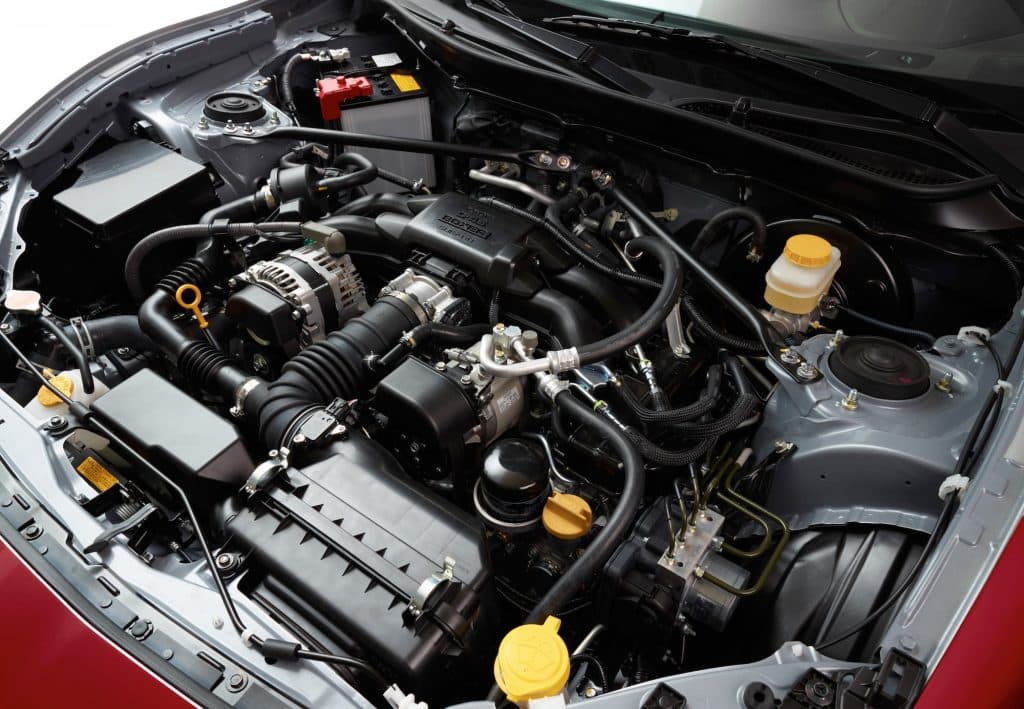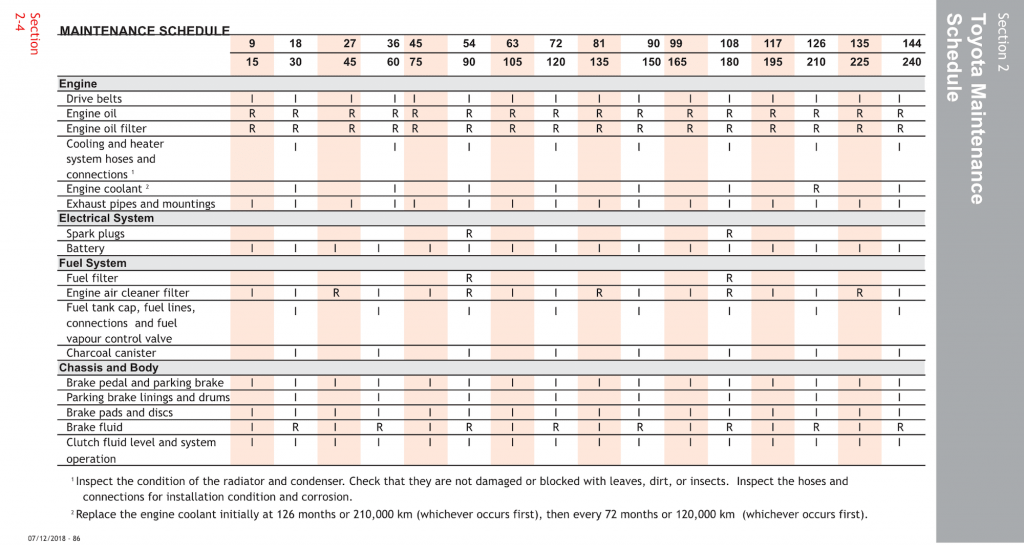Toyota 86 / GT 86 / Scion FR-S (2.0L, 2012-2021) Maintenance Schedule
This is the maintenance schedule for the Toyota 86, the rear-wheel-drive naturally aspirated sports car that Toyota produced from 2012-2021.
The Toyota 86 is also known as the Toyota GT86 (UK) and the Toyota Scion FR-S (in the US, where it was renamed the Toyota 86 from 2017).
The Toyota 86 / Scion FR-S is powered by a 1998cc liquid-cooled DOHC 4-valve-per-cylinder boxer engine with dual VVT. It has a square bore and stroke of 86x86mm, make it a “square boxer” — something that changed in its successor.
The Toyota 86’s engine is naturally aspirated. With a compression ratio of 12.5:1, it makes peak power of 151 kW (205 bhp) at 7000 rpm, and peak torque of 211 Nm (156 ft-lb) @ 6400 rpm. Power goes to the ground via a six-speed close-ratio manual or electronic automatic transmission and a rear wheel drive.
From 2022, the Toyota 86 / GT86 has been replaced with the 2.4L Toyota GR86.
This site has links for things like oil and spark plugs from which we earn a commission (which unfortunately nobody can save, not even us). If you appreciate this work, then please use those links. Thanks!
Maintenance Schedule for the Toyota GT86
Below is the maintenance schedule for the Toyota GT86.
The GT86 is released in a lot of markets worldwide, but each locale has a unique maintenance schedule. This is due to differences in regulations regarding emissions, maintenance, and safety.
- In Australia and Europe (and maybe other non-US regions), the service interval for the Toyota GT86 is 15000 km / 9000 miles.
- In the US, Toyota recommends servicing every 7500 miles (~12000 km)
How often you service your GT86 also depends on how you use it. If you drive it on dirt/dusty roads, in heavy traffic, or at the track, you will wear out certain components faster and need to service your car most often.
Toyota 86 / Scion FR-S maintenance schedule (US)
Below is the maintenance schedule from US manuals for the Toyota 86 or Scion FR-S.
Notes
- There is no break-in service scheduled (but many owners do one anyway)
- At the end of the break-in period, continue servicing it in the pattern shown
- Items marked (*) are to be serviced more often if you drive your car under harsh conditions (dirt roads, bumpy roads, stop-start traffic, extremes of heat/cold etc. — see the above section)
Legend:
- I: Inspect (and adjust, repair, or replace as necessary)
- R: Replace
- T: Tighten/ re-torque
| Miles (000) | 7.5 | 15 | 22.5 | 30 | |
|---|---|---|---|---|---|
| Months | 7.5 | 15 | 22.5 | 30 | Every |
| Engine oil and oil filter* | R | R | R | R | Under severe conditions, replace twice as often (every 3750 miles / 6000 km or 4 months) |
| Engine air filter | I* | I* | I* | R | See severe conditions table |
| Spark plugs | See below for “less frequent” maintenance | ||||
| Automatic transmission fluid | I | I | See below for “less frequent” maintenance | ||
| Clutch fluid and system operation | I | I | |||
| Brake lines and hoses | I* | I | I* | I | See severe conditions table |
| Brake pads and discs | I* | I | I* | I | See severe conditions table |
| Brake fluid | R* | R | See severe conditions table | ||
| Engine coolant | I | See below for “less frequent” maintenance | |||
| Bolts and nuts on chassis if driving on dirt and dusty roads | T | T | T | T | |
| Cabin air filter | I* | R | I* | R | See severe conditions table |
| Drive belt | I | ||||
| Drive shaft boots | I* | I | I* | I | See severe conditions table |
| Exhaust pipes and mountings | I | I | |||
| Drivers floor mat installation | I | I | I | I | |
| Fuel lines and connections, fuel tank vapor vent system hoses and fuel tank band | I* | I* | I* | I | See severe conditions table |
| Fuel filter* | See below for “less frequent” maintenance | ||||
| Fuel tank cap gasket | I | ||||
| Manual transmission oil | I | ||||
| Parking brake lining and drums | I* | I* | I* | I | See severe conditions table |
| Rear differential oil | I | I | |||
| Steering gear | I* | I | I* | I | See severe conditions table |
| Suspension ball joints and dust covers | I* | I | I* | I | See severe conditions table |
| Tire rotation | R | R | R | R | |
| Wiper blades | I | I | I | I |
Toyota 86 less frequent service (US)
Below are a few items that don’t fit neatly into the above table for the US Toyota 86. These items should be replaced relatively infrequently.
| Less frequent items | Replacement interval |
|---|---|
| Replace spark plugs | Every 60000 miles or 5 years |
| Replace automatic transmission fluid | Every 60000 miles or 5 years, or more often as needed |
| Replace fuel filter | Replace every 75000 miles or 6.25 years, or more often if driving in severe conditions |
| Replace engine coolant | Replace at 135000 miles (216000 km) or 11 years, then every 75000 miles (120000 km) or 6 years |
Toyota 86 / GT86 maintenance schedule (Europe / APAC)
Below is the full maintenance schedule for the Toyota 86 in Europe and APAC, including Australia. It’s a little different to the maintenance schedule specified in the US (and not just because it’s in metric units).
Notes
- Maintenance intervals: General service intervals for the Toyota 86 in Europe / APAC are every 9 months (0.75 years) or 15000 km.
- Where both are present, follow the earlier of distance or time-based intervals.
- Harsh conditions: Items marked (*) should be serviced more often if you drive in harsh conditions. These include
- Driving on rough, muddy or snow-melted roads
- Driving on dusty roads
- Extensive idling and or low speed driving for long distances
- Continuous high speed driving (at speeds greater than 140 km/h) for over 2 hours
- (and some other less likely conditions, like using your 86 as a taxi, or driving short distances in freezing conditions
- At the end of the indicated schedule, repeat the maintenance in the pattern shown.
- There is no break-in service prescribed, but some owners choose to do one anyway.
- Engine coolant replacement: This doesn’t fit into the schedule.For the Toyota 86, replace engine coolant initially at 10.5 years or 210000 km (whichever first), then every 6 years or 120000 km.
Legend:
- I: Inspect (and adjust, repair, or replace as necessary)
- R: Replace
- T: Tighten/ re-torque
| Years | 0.75 | 1.5 | 2.25 | 3 | 3.75 | 4.5 |
|---|---|---|---|---|---|---|
| km x 1000 | 15 | 30 | 45 | 60 | 75 | 90 |
| Engine | ||||||
| Drive belts | I | I | I | I | I | I |
| Engine oil | R | R | R | R | R | R |
| Engine oil filter | R | R | R | R | R | R |
| Inspect radiator and condenser (check not damaged or blocked) and heating system. Inspect hoses and connections for condition and corrosion. | I | I | I | |||
| Engine coolant See notes above on infrequent replacement | I | I | I | |||
| Exhaust pipes and mountings | I | I | I | I | I | I |
| Electrical System | ||||||
| Spark plugs | R | |||||
| Battery | I | I | I | I | I | I |
| Fuel filter | R | |||||
| Engine air cleaner filter | I | I | R | I | I | R |
| Fuel tank cap, fuel lines, connections and fuel vapour control valve | I | I | I | |||
| Charcoal canister | I | I | I | |||
| Chassis and Body | ||||||
| Brake pedal and parking brake | I | I | I | I | I | I |
| Parking brake linings and drums | I | I | I | |||
| Brake pads and discs | I | I | I | I | I | I |
| Brake fluid | I | R | I | R | I | R |
| Clutch fluid level and system operation | I | I | I | I | I | I |
| Brake pipes and hoses | I | I | I | |||
| Steering wheel, linkage and steering gear | I | I | I | I | I | I |
| Drive shaft boots | I | I | I | I | I | I |
| Suspension ball joints and dust covers | I | I | I | I | I | I |
| Manual transmission oil | I | I | I | |||
| Automatic transmission fluid | I | I | R | |||
| Rear differential oil | I | I | R | I | I | R |
| Front and rear suspensions | I | I | I | I | I | I |
| Bolts and nuts on chassis and body | T | T | T | T | T | T |
| Accessory items | I | I | I | I | I | I |
| Tyres and inflation pressures | I | I | I | I | I | I |
| Rotate wheels | I | I | I | I | I | I |
| Balance front wheels | I | I | I | I | I | I |
| Driver’s floor mat – fitment and retention | I | I | I | I | I | I |
| Lights, horns, wipers and washers | I | I | I | I | I | I |
| Seatbelt, webbing condition, buckle and retractor mechanism operation | I | I | I | I | I | I |
| Air conditioner filter | R | R | R | R | R | R |
| Air conditioner, including refrigerant level | I | I | I | I | I | I |
| Road Test | ||||||
| Road test vehicle | I | I | I | I | I | I |
About the Toyota 86 (a.k.a. Toyota GR86, Scion FR-S)

The Toyota 86 is a sports car in an iconic format — a front-mounted four-cylinder engine, rear wheel drive, and two-door chassis.
The Toyota 86 was initially known as the Scion FR-S in the US, and the Toyota GT86 in Europe. From model year 2017, Toyota renamed the Scion FR-S to the Toyota 86 in the US (see the press release here, also announcing some minor upgrades to the model).
But the Toyota 86 was fundamentally the same (other than where the steering wheel sits) regardless of geography.
Like the GR 86, the Toyota 86 / GT86 / Scion FR-S is based on the Subaru sibling, the BRZ. Both cars have an essentially identical engine and chassis, though with a different external appearance and the engine perhaps in a mildly different state of tune.

The heart of the Toyota 86 is what makes it special. In a world of souped up turbocharged engines driving advanced drivetrains, the Toyota 86’s motor is a 1998cc 4-cylinder boxer engine. It’s square, with an 86 x 86 mm bore and stroke (much like the Honda S2000, a car that holds a special place in many car owners’ hearts), and an aggressive 12.5:1 compression ratio.
The manual — and most owners go for manual — version of the Toyota 86 produces 205 SAE hp (153 kW) at 7000 rpm, and 156 ft-lb (211 Nm) of torque at 6400 rpm.
The 86 comes in both manual and automatic versions. You’ll probably have more fun with the manual one… and that reflects in the fact that the EPA estimated mileage for the automatic 86 is considerably better! The auto one is rated at 27 mpg combined; the manual at 24 combined.
There’s a lot that makes the Toyota 86 more than just a pretty package with a spritely engine.
Firstly, Toyota gave a lot of attention to the suspension. There’s a sport-tuned MacPherson strut at the front, and independent multi-link rear suspension at the back. You can also get the TRD handling package that gets you Sachs dampers all around.
Secondly, the centre of gravity on the Toyota 86 is very low. In fact, the seat height is the lowest in the entire line-up. Toyota also kept the engine’s centre of gravity low.
And finally, Toyota has given a lot of attention to appropriate chassis rigidity and tires.
The result is that the Toyota 86 can keep glued to the road when you need it, and has controlled oversteer on demand. This is what makes it so much fun for a modestly-powered car — it’s one you can push to its limits easily, and one in which you might even feel comfortable turning off all the electronics.
The Toyota 86 comes in a number of trim options. The base model gets you LED headlights, air con, cruise control, keyless entry, and sport seats… the basics that you need.
The Toyota 86 GT, or Toyota GT86 Pro in the UK gets you a spoiler, dual zone climate control, heated front seats, a 4.2 inch TFT display, and a smart key entry system. And some other stuff.
Maintaining your Toyota 86 is a little more difficult than if it had an inline four-cylinder engine as there are two cylinder heads to deal with. But oil and fluid changes are well within the means of the average owner.
Manual References for the Toyota 86
The above information came from the user’s manual, and the warranty and maintenance guide for the Toyota 86, as well as online public parts repositories.
The general maintenance schedule is the same for the Toyota 86 in different regions, but the service intervals are different. It’s up to you to decide how aggressively you’ll maintain your Toyota 86.


You can download manuals for Toyota cars from the US site here.








